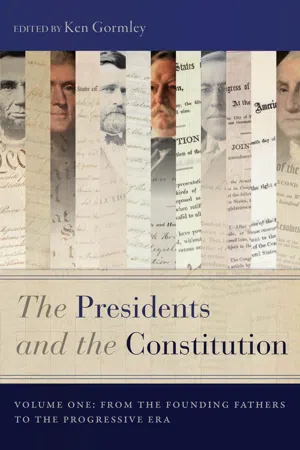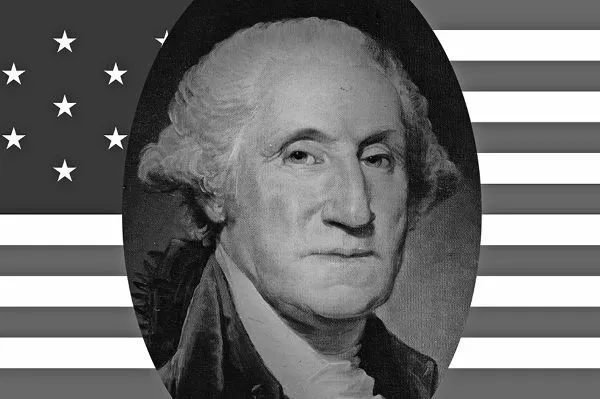Richard J. Ellis
Introduction
When it comes to the presidency, the Constitution of the United States is a document of remarkably few words. Most presidents navigate their way around the silences of the Constitution by emulating, rejecting, or modifying the actions of their predecessors. In the unique case of George Washington, who served as the nation’s first president from 1789 until 1797, there were no presidential precedents to help him figure out what the Constitution required or allowed. There was, of course, the British monarchical model, but few Americans—least of all Washington—wanted the president to be a king. There were also the diverse examples supplied by state governors, but the nation’s first president never understood his role to be that of a glorified governor. Washington shouldered the additional burden of knowing that his every step could become a precedent for his successors. Remarkably, the nation trusted this extraordinary power to shape the constitutional meaning of the presidential role to a relatively uneducated career military man whose direct experience in politics was limited to a few months as a delegate to the First and Second Continental Congresses during the mid-1770s.
Born in February 1732, George Washington grew up a farm boy in Virginia’s Tidewater region, where the crop of choice was tobacco and the workforce was largely slaves. Washington’s father was a hard-edged, upwardly mobile businessman who acquired acreage by the thousands. When Washington was eleven years old, his father died suddenly, leaving the family in a precarious position.1 At sixteen, with the family’s finances at a nadir and desirous of escaping from his exacting mother’s control, Washington took up surveying as a career, a fortuitous choice that would allow him to serve some of the wealthiest and best-connected landholders in Virginia. His knowledge of the backwoods of Virginia, acquired from his time as a surveyor, made him invaluable to the British military, and he spent much of his twenties distinguishing himself in the French and Indian War. His marriage to the widow Martha Dandridge Custis at age twenty-six helped make Washington one of the wealthiest men in Virginia. By the time he became president, Washington owned five farms totaling eight thousand acres, which were worked by three hundred slaves and were worth about half a billion in today’s dollars.2
Washington emerged from his twenties a very rich man but not a well-educated one. Unlike almost all the other famous founding fathers (John Adams, Thomas Jefferson, James Madison, and Alexander Hamilton), he neither went to college nor studied law. Washington may have been, as historian Gordon S. Wood writes, “a man of few words and no great thoughts,” but even as a relatively young man, he possessed the commanding bearing, self-discipline, and mature judgment that made him a leader whom other men were willing to follow.3
When the American Revolution broke out in 1775, the Second Continental Congress chose Washington to serve as commander in chief of the Continental Army, a post he held until the defeat of the British in 1783. General Washington was hailed as an exemplar of republican virtue for relinquishing military power the moment victory was assured.
In the spring of 1787, Washington came out of retirement to preside over the Constitutional Convention in Philadelphia. Seated on a raised platform in front of the other delegates, he managed to appear detached from the convention’s often-rancorous debate. However, he consistently voted with those delegates, like his fellow Virginian James Madison, who favored a strong national government and an independent executive branch. Although the prospect of a strong executive conjured up images of monarchy and despotism among many of the delegates, a majority of the fifty-five convention delegates ended up supporting the creation of a single, independent chief executive. That support probably owed a great deal to the knowledge that the new office would be filled first by Washington.4
On September 17, 1787, four months after the convention had begun, the delegates approved the new Constitution and sent it to the states for ratification. After a prolonged debate between those in favor of the Constitution, who referred to themselves as “Federalists,” and the “Anti-Federalists,” who opposed it, the Constitution was ratified by the requisite number of states. On September 13, 1788, the Congress of the Confederation certified the new Constitution and set the date (March 4, 1789) for the first meeting of the new government. Washington had anxiously monitored the ratification process from Mount Vernon, knowing that he would certainly be selected the nation’s first president. True to form, each of the sixty-nine presidential electors cast his ballot for Washington in the nation’s first presidential election.
Presidency
Washington was acutely aware that fears of executive power remained a potent part of American political culture. He also knew that the leading statesmen in the new nation remained jealously solicitous of legislative prerogatives. Washington understood that building support for the new Constitution and fostering trust in the presidency required him to exercise great self-restraint, particularly in his interactions with the legislative branch.
Relationship with Congress
Washington’s self-restraint was evident in the cautious approach he took toward the veto power granted him by Article I, Section 7, of the Constitution. He admitted to a friend that he signed “many Bills” with which he disagreed. Indeed, during eight years as president, Washington vetoed only two bills. The first, at the end of his first term, was an apportionment bill, which Washington vetoed at the insistence of his secretary of state, Thomas Jefferson. Not only did Jefferson believe that the bill was unconstitutional, he also feared that “non-use” of the veto was beginning “to excite a belief that no President will ever venture to use it.” Washington did not exercise his next and last veto—of a bill that disbanded two dragoon companies—until four days before he was to leave office.5
Washington also cooperated with Congress when it requested information, even some embarrassing information related to military policy. When the House of Representatives requested War Department documents relating to General Arthur St. Clair’s humiliating defeat at the hands of American Indians in November 1791, Washington could easily have stonewalled. The Constitution, after all, did not specify what information the president was required to divulge to Congress. Well aware, however, that his response might “become a precedent” and that Congress might in the future request papers “of so secret a nature as that they ought not to be given up,” Washington gave the House investigating committee all the information it requested.6
Washington’s public communications with Congress were unfailingly deferential. His speeches and messages were never scolding or confrontational. In his inaugural address, he chose to avoid altogether any “recommendation of particular measures.” Instead, he paid “the tribute that is due to the talents, the rectitude, and the patriotism . . . [of the legislators] selected to devise and adopt them.” In his first annual message, he dutifully drew Congress’s attention to the issues that he believed required legislative action, yet he was careful to avoid specifying what legislation he thought should be adopted.
Behind the scenes, however, President Washington was not entirely passive in shaping legislation, particularly on matters relating to national defense. For instance, his first annual message vaguely referenced the need to establish a “uniform and well-digested plan” for a militia, yet Washington had already drawn up a more specific plan and instructed Secretary of War Henry Knox to work it “into the form of a Bill with which to furnish . . . Congress.” It turned out that the First Congress did not share the president’s sense of urgency and took no action on the administration’s bill. Although deeply disappointed, Washington bore the setback stoically and did not attempt to lobby legislators on behalf of his preferred plan.7
Washington had strategic reasons for wishing to avoid being drawn too deeply into the legislative process. For one, taking sides in fractious legislative debates would jeopardize his carefully cultivated reputation as a president above party and faction. In addition, he believed that attempting to influence Congress would be counterproductive because doing so could trigger charges of executive usurpation and arouse legislative resentment. Finally, Washington feared that by intervening in the legislative process, he could damage the prestige of his own presidency and that of future presidents.8
However, Washington’s restraint was more than just a tactical or political calculation. It also reflected his strict interpretation of the separation of powers embodied in the newly adopted Constitution. Washington believed that the Constitution required the executive not to encroach on legislative powers just as much as it commanded the legislature not to encroach on executive powers. When he thought Congress had trespassed on executive powers, Washington was quick to protest. For instance, when the House of Representatives passed a resolution congratulating the French on adopting their new constitution, Washington complained to Jefferson that the legislature was “endeavoring to invade the executive.” At the same time, Washington showed a principled regard for legislative prerogatives. When Attorney General Edmund Randolph suggested an administrative fix to a troublesome law, Washington demurred, insisting that the Constitution “must mark the line of [the president’s] official conduct.” Washington informed Randolph that he “could not justify . . . taking a single step in any matter, which appeared to . . . require [the legislature’s] agency, without its being first obtained.” Congress and the president, in Washington’s view, properly occupied sepa...

